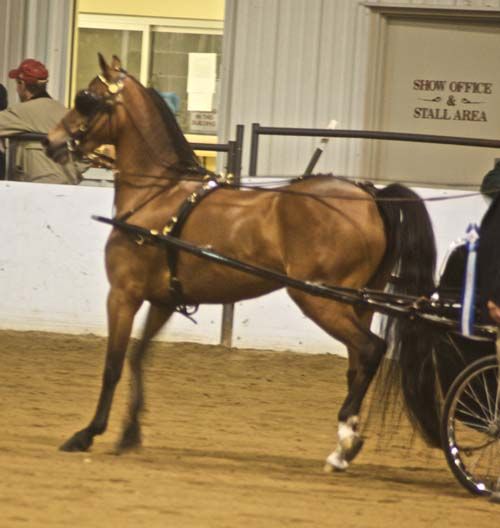
With its high-stepping, flashy knee action and easy trainable nature, it's no wonder that the Hackney Horse is such a great driving horse. But despite this horse's talents in the show ring and as a pleasure driving horse, this breed is endangered. With less than 200 of these horses living in the United States today, the Hackney is rare and hard to find.
Size
Hackney horses are usually between 15 and 16 hands tall, weighing between 1,000 and 1,200 pounds. Stallions tend to be larger and more muscular than mares and horses who are gelded early on in life. Hackney Ponies, which originated from Hackney horses that were bred to Welsh and Fell ponies, stand at 14.2 hands high and under.
Colours
Hackneys have primarily dark, solid-colored coats in bay, chestnut, and black shades. Horses may have white leg or face markings.
Suitable for
Hackneys are mainly used for driving, and their high-stepping action makes them flashy, impressive carriage horses. Hackneys are usually shown in single, pair, and four-horse driving arrangements. They also compete in combined driving events, their speed and agility giving them an advantage.
While these horses are most commonly used for driving, they can be ridden and the Hackney does well in dressage and jumping.
Because the Hackney has been an endangered breed, breeding programs are limited and hard to find. With the recent increased interest in carriage driving, these horses are being sought out more often, so it's possible that more breeding programs will be created or will grow in size in the near future.
Hackney Horse History and Origins
The origins of the Hackney Horse begin in Norfolk, England in the mid-1700s. Breeders crossed the Norfolk Trotter with Thoroughbreds, gradually developing the Hackney breed. During the 1800s, this breed became highly popular in Britain because of its speed and power as a light carriage horse.
In the late 1800s, the Hackney was imported to the United States. While still used as a driving horse, the Hackney was frequently crossed with pony breeds for smaller, more compact ponies known as Hackney Ponies.
Today, the Hackney Horse is relatively uncommon and it's estimated that fewer than 3,000 of these horses are alive today. Of those horses, the majority are located in Britain, with only about 200 residing in the United States. Conserving this breed is a high priority. In contrast, the Hackney Pony is highly popular and doesn't have the same conservation needs as the Hackney Horse.
:max_bytes(150000):strip_icc():format(webp)/what-horses-eat-that-keep-them-healthy-1886504-FINAL-5ba8dd3746e0fb0025eb2cb4.png)
:max_bytes(150000):strip_icc():format(webp)/horse-eye-resized-56a4dbf03df78cf77284fe95.jpg)
:max_bytes(150000):strip_icc():format(webp)/Horse-grooming-GettyImages-495726400-5876f27d5f9b584db351222e.jpg)
:max_bytes(150000):strip_icc():format(webp)/close-up-of-hand-holding-parrot-705172843-5b52bc4ec9e77c0037b6e5a4.jpg)
:max_bytes(150000):strip_icc():format(webp)/GettyImages-579524112-5c77331146e0fb000140a3a6.jpg)
:max_bytes(150000):strip_icc():format(webp)/budgerigarsonrope-331834_1920-5b628213c9e77c00255b32bc.jpg)
:max_bytes(150000):strip_icc():format(webp)/GettyImages-106887241-58325bc03df78c6f6a9a2ed2.jpg)
:max_bytes(150000):strip_icc():format(webp)/GettyImages-878015800-06106157c9d34a2081db4abcae8699b1.jpg)
:max_bytes(150000):strip_icc():format(webp)/hungry-cat-57b72fac5f9b58cdfda11a62.jpg)


:max_bytes(150000):strip_icc():format(webp)/4374985466_59c7f6545b_o-8b4f24f2f3e544349fe537fde58cfad0.jpg)
:max_bytes(150000):strip_icc():format(webp)/GettyImages-9298737261-500c5a2fba4248f89d1c17a33bf438f7.jpg)
:max_bytes(150000):strip_icc():format(webp)/veterinarian-and-owners-examining-dog-in-vet-s-surgery-164853745-dbecbdb691d549d79487d84356920cf4.jpg)